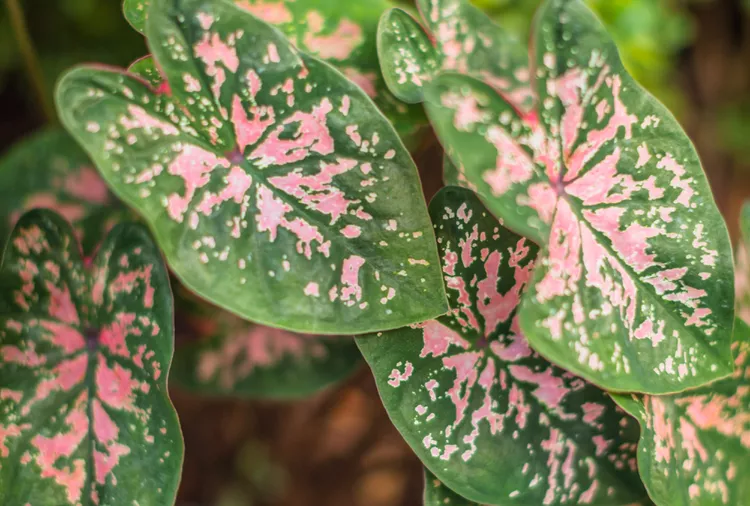Caladiums are stunning tropical plants with colorful leaves that brighten up shadier areas in your garden. But are caladiums perennials that grow back every year after the winter? Or will you need to buy new plants to replace them in the spring? Here's what you need to know to get the most out of your caladiums and keep them growing yearly.
Caladiums were initially limited to shadier locations, with just a couple hours a day of dappled sun or less intense morning sunlight. However, newer varieties can take some direct sunlight, especially in more northern areas.
What Are Caladiums?
Caladiums are perennial plants that will only grow back in frost-free areas after winter. Hardy in Zones 9-13, these tropical plants are easily killed by a freeze and don’t do well in cool weather. Anything cold enough to warrant a coat for you is generally too chilly for them. However, don’t despair. Caladiums can be grown as annuals and houseplants or planted outside and dug up each year like dahlias.
Caladiums grow from a bulb (technically called a tuberous corm). When purchasing, you may notice different bulbs of different sizes. Foliage grows directly from buds on the bulbs, and the more of them, the more foliage you’ll get. Larger bulbs, therefore, command a higher price. Bags of caladium bulbs from a big box store are likely smaller bulbs. They’ll still grow; they just won’t make as much foliage. However, smaller bulbs can be planted closer together to create a fuller effect.
Most caladiums grown in gardens are cultivars of Caladium bicolor, and there are hundreds to choose from. Caladiums are sometimes referred to as elephant ears or angel wings but check for the genus name Caladium on the plant tag. Other plants, such as alocasias, also go by those common names.
Overwintering Caladium Bulbs
Many gardeners treat caladiums as annuals and let them die at the end of the season when cold weather arrives. Then, they buy new caladiums to plant the following year. However, if you have a caladium you like or want to save the expense, you can dig up the corms in early fall and store them in a protected spot until warmer weather returns in spring. Just be sure to dig up your caladiums before your area's first fall frost. Then follow these steps:
- Carefully dig up the corms with a trowel.
- Snip off any remaining leaves or roots.
- Let the bulbs dry in a shaded spot that will stay above freezing for a few days.
- When dry, place the bulbs in a cardboard box filled with wood shavings or straw.
- Store the box in a cool, dark spot. The back of a closet or a basement shelf will suffice.
- In spring, begin waking up the bulbs by potting them up indoors in a warm spot. Or plant them outside after the soil has warmed.
If you grew your caladiums in containers on the deck or patio all summer, you have it easy in the fall. Just snip off the remaining foliage once it begins to die back and bring the whole pot into an unheated garage or shed that will stay above freezing. In spring, move the pot outside once all danger of frost has passed.
When and How to Plant Caladium Bulbs
Caladiums can be purchased as bulbs ready to go in the ground or as nursery plants. Northern gardeners may want to start their caladiums indoors to get a head start on the season.
Planting Caladiums Indoors
- Select a pot with drainage holes.
- Fill the pot with fresh potting mix.
- Place the bulbs in the potting mix with the eyes facing up and lightly cover the entire bulb.
- Water well and then wait for foliage to appear. Don’t keep watering before the leaves pop up and risk rotting the bulbs.
Planting Caladiums Outdoors
- Wait for soil temperatures to reach 70°F. Caladiums won’t grow in colder temperatures, and the bulbs are prone to rot in cold, wet soil.
- Work in compost or aged manure into the garden bed. Use a high-quality potting mix for containers and add some finished compost.
- Place the bulbs two inches deep and cover them with soil.
- Larger bulbs in the garden should be at least 8 inches apart. Smaller bulbs or those in containers can be closer together.
Our Recommended Garden Tools
Good garden tools can make working with plants, trees, and shrubs much easier. We like these trowels for digging holes to plant bulbs and seeds and for weeding, and these garden hoses and reels are the best on the market for all your water-related chores. A plant moisture meter can help you avoid over- or under-watering your flowers and vegetables. Recycle your food scraps and use them to fertilize your plants with a compost bin that fits your needs. If you have a large lawn, a ride-on mower is a lifesaver and makes the job a bit more fun, too.




















